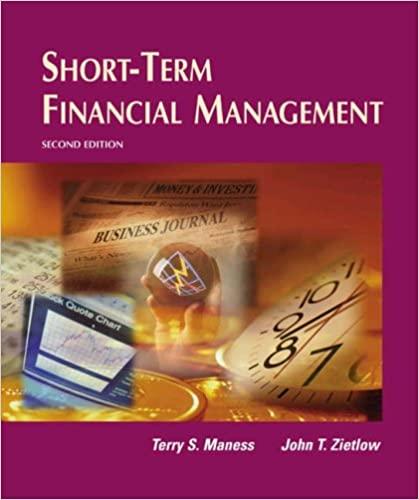Question
Consider the following information: Portfolio Expected Return Standard Deviation Risk-free 11 % 0 Market 16.0 1.0 A 12.0 0.7 a. Calculate the expected return of
Consider the following information:
| Portfolio | Expected Return | Standard Deviation | |
| Risk-free | 11 | % | 0 |
| Market | 16.0 | 1.0 | |
| A | 12.0 | 0.7 | |
|
| |||
a. Calculate the expected return of portfolio A with a beta of 0.7. (Round your answer to 2 decimal places.)
Expected return %
b. What is the alpha of portfolio A. (Negative value should be indicated by a minus sign. Round your answer to 2 decimal places.)
Alpha %
2.
I am buying a firm with an expected perpetual cash flow of $630 but am unsure of its risk. If I think the beta of the firm is zero, when the beta is really 1, how much more will I offer for the firm than it is truly worth? Assume the risk-free rate is 6% and the expected rate of return on the market is 18%. (Input the amount as a positive value.)
Present value difference $
3.
Assume both portfolios A and B are well diversified, that E(rA) = 15.2% and E(rB) = 17.6%. If the economy has only one factor, and A = 1 while B = 1.3,What must be the risk-free rate? (Do not round intermediate calculations. Round your answer to 1 decimal place.)
Risk-free rate %
4.
Assume a market index represents the common factor and all stocks in the economy have a beta of 1. Firm-specific returns all have a standard deviation of 36%.
Suppose an analyst studies 20 stocks and finds that one-half have an alpha of 3.2%, and one-half have an alpha of 3.2%. The analyst then buys $1.6 million of an equally weighted portfolio of the positive-alpha stocks and sells short $1.6 million of an equally weighted portfolio of the negative-alpha stocks.
a. What is the expected return (in dollars), and what is the standard deviation of the analysts profit? (Enter your answers in dollars not in millions. Do not round intermediate calculations. Round your answers to the nearest dollar amount.)
| Expected return | $ |
| Standard deviation | $ |
|
| |
b-1. How does your answer change if the analyst examines 50 stocks instead of 20? (Enter your answer in dollars not in millions. Do not round intermediate calculations. Round your answer to the nearest dollar amount.)
Standard deviation $
b-2. How does your answer change if the analyst examines 100 stocks instead of 20? (Enter your answer in dollars not in millions.)
Standard deviation $
5.
Suppose there are two independent economic factors, M1 and M2. The risk-free rate is 6%, and all stocks have independent firm-specific components with a standard deviation of 50%. Portfolios A and B are both well diversified.
| Portfolio | Beta on M1 | Beta on M2 | Expected Return (%) |
| A | 1.6 | 2.5 | 40 |
| B | 2.4 | -0.7 | 10 |
|
| |||
What is the expected returnbeta relationship in this economy? (Do not round intermediate calculations. Round your answers to 2 decimal places.)
Expected returnbeta relationship E(rP) = % + P1 + P2
Step by Step Solution
There are 3 Steps involved in it
Step: 1

Get Instant Access to Expert-Tailored Solutions
See step-by-step solutions with expert insights and AI powered tools for academic success
Step: 2

Step: 3

Ace Your Homework with AI
Get the answers you need in no time with our AI-driven, step-by-step assistance
Get Started


